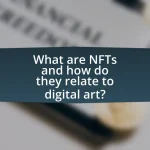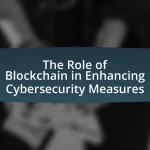Blockchain technology is revolutionizing voting systems globally by improving security, transparency, and accessibility. Its decentralized nature ensures that votes are recorded in an immutable ledger, significantly reducing the risk of tampering and fraud. Key features such as transparency, security, and decentralization enhance the integrity of the electoral process, as demonstrated by successful implementations in places like Utah County, USA, and Estonia. The article explores the challenges faced by traditional voting methods, the benefits of blockchain integration, and the future implications for electoral systems, highlighting the need for transformation to restore public trust and increase voter participation.

How is Blockchain Transforming Voting Systems Worldwide?
Blockchain is transforming voting systems worldwide by enhancing security, transparency, and accessibility. The decentralized nature of blockchain technology ensures that votes are recorded in an immutable ledger, making it nearly impossible to alter or tamper with the results. For instance, in 2020, Utah County in the United States successfully implemented a blockchain-based voting system for overseas voters, which allowed for secure and verifiable voting while maintaining voter anonymity. This approach not only increases trust in the electoral process but also facilitates participation from remote locations, thereby improving voter turnout. Additionally, studies have shown that blockchain can reduce the costs associated with traditional voting methods by streamlining the voting process and minimizing the need for physical polling places.
What are the key features of blockchain technology that enhance voting systems?
The key features of blockchain technology that enhance voting systems include transparency, security, immutability, and decentralization. Transparency allows all participants to verify the voting process and results, fostering trust among voters. Security is achieved through cryptographic techniques that protect voter identities and prevent tampering. Immutability ensures that once a vote is recorded, it cannot be altered or deleted, which safeguards against fraud. Decentralization eliminates the need for a central authority, reducing the risk of manipulation and increasing resilience against attacks. These features collectively contribute to a more reliable and trustworthy voting process.
How does decentralization improve the integrity of voting?
Decentralization improves the integrity of voting by distributing the control and verification of votes across multiple nodes rather than relying on a single central authority. This distribution reduces the risk of manipulation or fraud, as altering the results would require compromising numerous independent systems simultaneously. For instance, blockchain technology, which operates on a decentralized ledger, ensures that once a vote is recorded, it cannot be altered without consensus from the network, thereby enhancing transparency and accountability. Studies have shown that decentralized voting systems can significantly reduce instances of tampering, as evidenced by pilot programs in various jurisdictions that have successfully utilized blockchain to secure election processes.
What role does transparency play in blockchain-based voting?
Transparency is crucial in blockchain-based voting as it ensures the integrity and trustworthiness of the electoral process. By allowing all participants to view and verify transactions on a public ledger, blockchain technology minimizes the risk of fraud and manipulation. For instance, a study by the Massachusetts Institute of Technology highlighted that blockchain’s immutable nature prevents unauthorized changes to votes, thereby enhancing accountability. This transparency fosters public confidence in the voting system, as stakeholders can independently verify the accuracy of the results.
Why is there a need for transformation in traditional voting systems?
There is a need for transformation in traditional voting systems to enhance security, transparency, and accessibility. Traditional voting methods are often vulnerable to fraud, manipulation, and errors, which can undermine public trust in electoral processes. For instance, a study by the Brennan Center for Justice highlights that nearly 1 in 5 voters faced problems at the polls in the 2020 U.S. elections, indicating systemic issues that require reform. Additionally, the integration of blockchain technology can provide a decentralized and immutable record of votes, significantly reducing the risk of tampering and increasing voter confidence.
What are the common issues faced in conventional voting methods?
Common issues faced in conventional voting methods include voter fraud, lack of transparency, and accessibility challenges. Voter fraud can occur through various means, such as ballot stuffing or impersonation, undermining the integrity of elections. Lack of transparency arises from complex processes that make it difficult for the public to verify results, leading to distrust in the electoral system. Accessibility challenges affect individuals with disabilities or those in remote areas, limiting their ability to participate in the voting process. According to a report by the Brennan Center for Justice, these issues contribute to lower voter turnout and diminished public confidence in democratic processes.
How can blockchain address voter fraud and manipulation?
Blockchain can address voter fraud and manipulation by providing a secure, transparent, and immutable ledger for recording votes. This technology ensures that each vote is recorded as a unique transaction, making it nearly impossible to alter or delete once cast. The decentralized nature of blockchain eliminates the risk of a single point of failure, reducing the chances of tampering by malicious actors.
For instance, a study by the University of California, Berkeley, highlighted that blockchain’s cryptographic techniques can enhance the integrity of the voting process by allowing voters to verify their votes without compromising their anonymity. Additionally, the use of smart contracts can automate and enforce voting rules, further minimizing the potential for fraud. These features collectively create a more trustworthy electoral system, as evidenced by pilot projects in countries like Estonia, where blockchain has been successfully implemented in e-voting systems.

What are the global examples of blockchain implementation in voting?
Global examples of blockchain implementation in voting include the 2019 municipal elections in Utah County, USA, where Voatz, a mobile voting platform using blockchain technology, allowed overseas voters to cast their ballots securely. Another example is the 2020 presidential election in Sierra Leone, which utilized blockchain to enhance transparency and trust in the electoral process. Additionally, in 2021, the city of Zug in Switzerland conducted a blockchain-based voting trial for its residents, demonstrating the feasibility of digital voting systems. These implementations showcase the potential of blockchain to improve security, transparency, and accessibility in voting processes.
Which countries have successfully adopted blockchain for elections?
Estonia and Switzerland have successfully adopted blockchain technology for elections. Estonia has implemented blockchain in its e-voting system since 2005, allowing secure and transparent voting for its citizens. Switzerland has conducted trials using blockchain for voting in various cantons, notably in Zug, where residents could vote on local issues using a blockchain-based system. These implementations demonstrate the effectiveness of blockchain in enhancing election security and transparency.
What lessons can be learned from Estonia’s e-voting system?
Estonia’s e-voting system demonstrates the importance of security, transparency, and accessibility in digital voting. The system employs advanced cryptographic techniques to ensure voter anonymity and data integrity, which are crucial for maintaining public trust. Additionally, Estonia’s experience highlights the need for robust cybersecurity measures, as the country has faced cyber threats but successfully mitigated risks through continuous updates and monitoring. Furthermore, the system’s user-friendly interface encourages higher voter participation, showcasing that ease of use can significantly impact electoral engagement. These lessons emphasize that a well-designed e-voting system can enhance democratic processes while addressing security and accessibility challenges.
How did Utah County implement blockchain in their voting process?
Utah County implemented blockchain in their voting process by utilizing a blockchain-based voting system for overseas voters during the 2020 election. This system allowed voters to securely cast their ballots using a mobile application that recorded votes on a blockchain, ensuring transparency and security. The implementation aimed to enhance accessibility for military and overseas voters while maintaining the integrity of the election process, as verified by the county’s election officials and the technology provider, Voatz, which specializes in blockchain voting solutions.
What challenges have been encountered in these implementations?
Challenges encountered in the implementation of blockchain in voting systems include technical complexity, scalability issues, and security concerns. Technical complexity arises from the need for specialized knowledge to develop and maintain blockchain systems, which can hinder widespread adoption. Scalability issues are evident as many blockchain networks struggle to handle a high volume of transactions simultaneously, potentially leading to delays during elections. Security concerns involve the risk of cyberattacks and the integrity of the voting process, as any vulnerabilities could undermine public trust. These challenges have been documented in various studies, including a report by the National Academy of Sciences, which highlights the importance of addressing these issues to ensure the effective use of blockchain in electoral processes.
What technical hurdles must be overcome for successful blockchain voting?
Successful blockchain voting requires overcoming several technical hurdles, including scalability, security, user accessibility, and interoperability. Scalability issues arise from the need to handle a large number of transactions simultaneously during elections, which can overwhelm existing blockchain networks. Security concerns involve ensuring the integrity of votes and protecting against hacking or manipulation, as evidenced by incidents in previous digital voting systems. User accessibility is critical, as voters must be able to easily use the technology without extensive technical knowledge, which can be a barrier for some populations. Lastly, interoperability between different blockchain systems and traditional voting infrastructures is necessary to ensure a seamless integration of blockchain voting into existing electoral processes.
How do public perceptions affect the adoption of blockchain voting systems?
Public perceptions significantly influence the adoption of blockchain voting systems by shaping trust and acceptance among voters. When the public views blockchain technology as secure and transparent, they are more likely to support its implementation in voting processes. For instance, a survey conducted by the Pew Research Center in 2021 indicated that 56% of respondents believed that technology could improve the electoral process, highlighting a positive perception that can drive adoption. Conversely, skepticism regarding the security and reliability of blockchain can hinder its acceptance, as seen in various studies where concerns about hacking and privacy issues were prevalent among voters. Thus, public perceptions directly correlate with the willingness to embrace blockchain voting systems, impacting their successful integration into electoral frameworks.

What are the future implications of blockchain in voting systems?
The future implications of blockchain in voting systems include enhanced security, increased transparency, and improved voter accessibility. Blockchain technology can secure votes against tampering and fraud through its decentralized and immutable nature, which ensures that once a vote is recorded, it cannot be altered. Additionally, the transparency of blockchain allows for real-time auditing of votes, fostering trust in the electoral process. Studies, such as those conducted by the National Institute of Standards and Technology, indicate that blockchain can streamline the voting process, making it more accessible to remote voters and those with disabilities, thereby potentially increasing voter turnout.
How might blockchain technology evolve in the context of voting?
Blockchain technology may evolve in the context of voting by enhancing security, transparency, and accessibility in electoral processes. As governments and organizations explore decentralized systems, blockchain can provide immutable records of votes, reducing the risk of fraud and manipulation. For instance, pilot projects in countries like Estonia have demonstrated the feasibility of blockchain-based voting, where voter identities are securely verified, and votes are recorded on a tamper-proof ledger. This evolution could lead to wider adoption of remote voting solutions, enabling participation from citizens regardless of their location, thereby increasing voter turnout and engagement.
What innovations could enhance voter engagement and accessibility?
Innovations such as blockchain technology, mobile voting applications, and online voter registration systems can significantly enhance voter engagement and accessibility. Blockchain technology ensures secure and transparent voting processes, which can increase trust in elections and encourage participation. Mobile voting applications allow voters to cast their ballots from anywhere, removing barriers related to transportation and time constraints. Online voter registration systems streamline the registration process, making it easier for individuals to register and participate in elections. These innovations collectively address common obstacles faced by voters, thereby promoting higher engagement and accessibility in the electoral process.
How can blockchain voting systems adapt to changing regulations?
Blockchain voting systems can adapt to changing regulations by implementing flexible governance frameworks that allow for rapid updates and compliance with new legal requirements. These systems can utilize smart contracts to automate compliance checks and ensure that voting processes align with the latest regulations, thereby enhancing transparency and security. For instance, jurisdictions that have adopted blockchain voting have demonstrated the ability to modify their protocols in response to legislative changes, as seen in the 2020 U.S. elections where several states adjusted their voting methods to accommodate remote voting due to the pandemic. This adaptability is crucial for maintaining public trust and ensuring the integrity of the electoral process.
What best practices should be followed for implementing blockchain in voting?
Best practices for implementing blockchain in voting include ensuring transparency, enhancing security, and promoting accessibility. Transparency can be achieved by allowing all stakeholders to view the voting process and results on the blockchain, which fosters trust. Security is critical; utilizing cryptographic techniques protects voter identities and prevents tampering. Additionally, accessibility must be prioritized to ensure that all eligible voters can participate, which may involve developing user-friendly interfaces and providing support for various demographics. These practices are supported by successful implementations in countries like Estonia, where blockchain technology has been used to secure online voting since 2005, demonstrating its effectiveness in enhancing electoral integrity.
How can stakeholders ensure security and privacy in blockchain voting?
Stakeholders can ensure security and privacy in blockchain voting by implementing robust cryptographic techniques and decentralized consensus mechanisms. Cryptographic methods, such as public-private key encryption, protect voter identities and ensure that votes remain confidential. Additionally, decentralized consensus mechanisms, like proof-of-stake or proof-of-work, prevent tampering and ensure that all transactions are verified by multiple nodes, enhancing the integrity of the voting process. Research indicates that these methods significantly reduce the risk of fraud and unauthorized access, as evidenced by successful implementations in various pilot projects worldwide, demonstrating their effectiveness in maintaining both security and privacy in electoral systems.
What strategies can be employed to educate voters about blockchain technology?
To educate voters about blockchain technology, strategies such as community workshops, online educational platforms, and partnerships with local organizations can be employed. Community workshops provide hands-on experiences and direct interaction with experts, fostering understanding through practical demonstrations. Online educational platforms, like webinars and interactive courses, can reach a broader audience, allowing voters to learn at their own pace. Collaborating with local organizations, such as civic groups and schools, can enhance outreach efforts and ensure that educational materials are accessible and relevant to the community’s needs. These strategies have been shown to increase awareness and understanding of complex technologies, as evidenced by initiatives in various regions that successfully improved public knowledge about digital tools.










